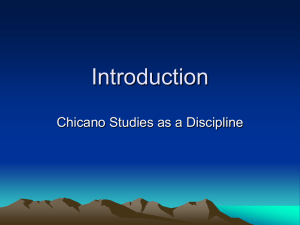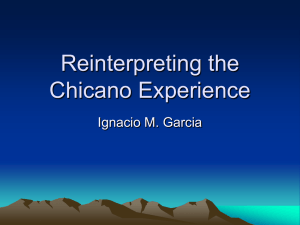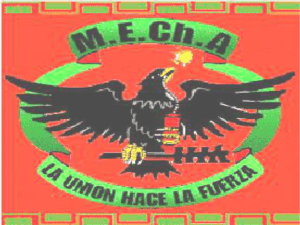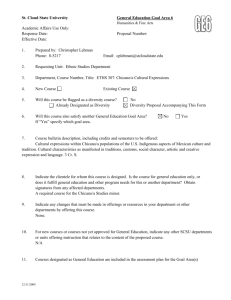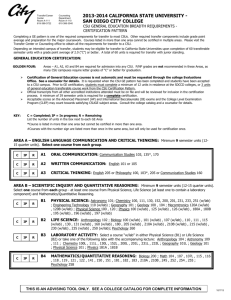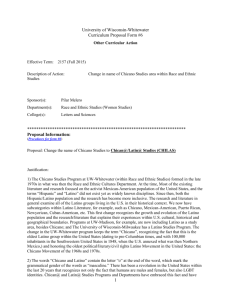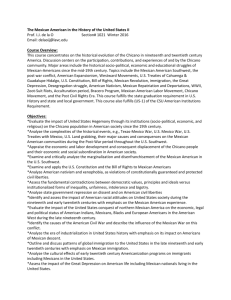Chicano Studies 141b
advertisement
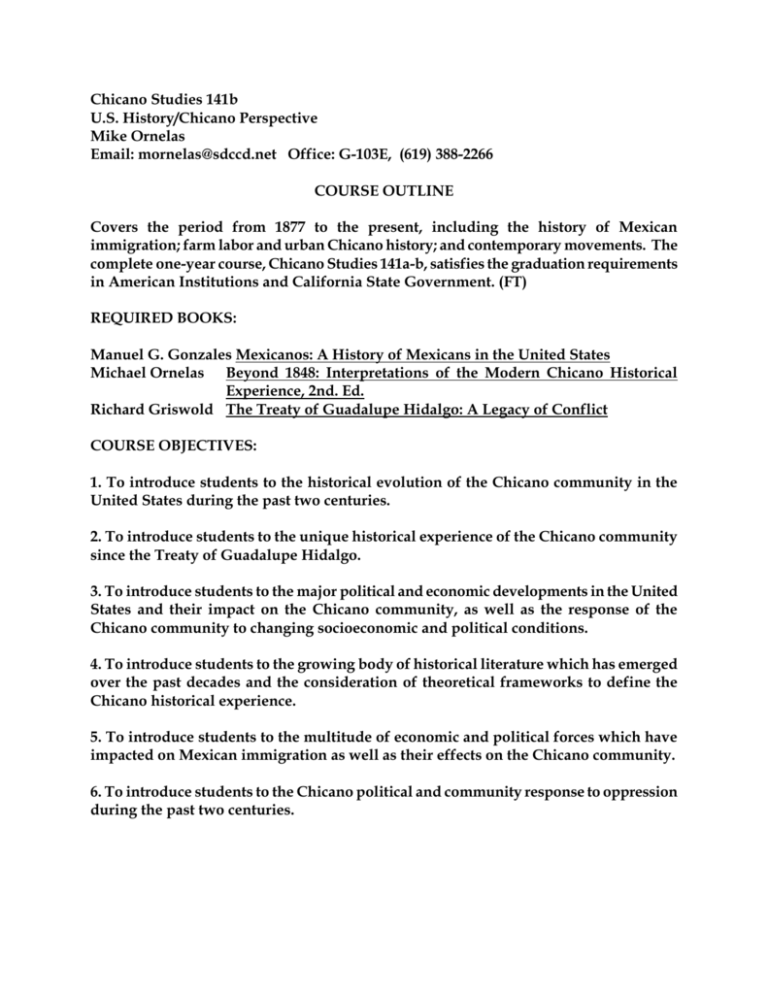
Chicano Studies 141b U.S. History/Chicano Perspective Mike Ornelas Email: mornelas@sdccd.net Office: G-103E, (619) 388-2266 COURSE OUTLINE Covers the period from 1877 to the present, including the history of Mexican immigration; farm labor and urban Chicano history; and contemporary movements. The complete one-year course, Chicano Studies 141a-b, satisfies the graduation requirements in American Institutions and California State Government. (FT) REQUIRED BOOKS: Manuel G. Gonzales Mexicanos: A History of Mexicans in the United States Michael Ornelas Beyond 1848: Interpretations of the Modern Chicano Historical Experience, 2nd. Ed. Richard Griswold The Treaty of Guadalupe Hidalgo: A Legacy of Conflict COURSE OBJECTIVES: 1. To introduce students to the historical evolution of the Chicano community in the United States during the past two centuries. 2. To introduce students to the unique historical experience of the Chicano community since the Treaty of Guadalupe Hidalgo. 3. To introduce students to the major political and economic developments in the United States and their impact on the Chicano community, as well as the response of the Chicano community to changing socioeconomic and political conditions. 4. To introduce students to the growing body of historical literature which has emerged over the past decades and the consideration of theoretical frameworks to define the Chicano historical experience. 5. To introduce students to the multitude of economic and political forces which have impacted on Mexican immigration as well as their effects on the Chicano community. 6. To introduce students to the Chicano political and community response to oppression during the past two centuries. The Chicano Studies 141b page 2 GRADES: Final grades will be determined through a combination of criteria that will include the following formula: Attendance, participation in class discussion and quizzes will comprise 25% of the grade. There will be 3 major written exams that will each comprise 25% of the grade (75% total). Exams will be based upon class discussion, lecture and most of the reading assignments. It is essential that each student continue to read all assignments in advance of each class session. There will be an optional paper that may be substituted for the second exam and/or replace one exam score. In addition, commentary and analysis of the various reading assignments are strongly encouraged. It is the students' responsibility to be aware of the reading assignments under discussion for a particular week. Make-up exams or assignments will only permitted under extraordinary or emergency situations. COURSE CONTENT AND FORMAT: Chicano Studies 141b is a continuation of 141a. The emphasis is on the recent historical experience of the Chicano community in the United States since the mid-19th century. Major emphasis will be placed on those economic, political and social conditions that have impacted on the formation of this community. As a general historical survey, the course will emphasize the role of American political institutions and practices in the oppression of the aspirations of the Chicano in American society. In addition, the 20th century focus will be on those factors that have influenced Mexican immigration, the establishment of dual-wage structures, the Mexican response to conditions in the U.S., Chicano efforts to unify and politicize the Chicano community, and the emergence of the Chicano community as a major force in the political and cultural life of the United States. MAJOR PERIODS, TOPICS, AND READING ASSIGNMENTS: I. The 19th Century Chicano Experience The Texas Revolt, the Mexican American War and the Treaty of Guadalupe Hidalgo The Texas Example, the dominant class, gender politics, Cortina 19th Century New Mexico, "fantasy heritage," the land grab, Resistance in the 19th century Arizona, Euroamerican Colonialism, Institutionalized Subordination economic development and Mexican labor, La Liga Protectora California, The conquest, California Land Act of 1851, El Clamor Publico, social and political resistance, nativism, The Treaty of Guadalupe Hidalgo, negotiation, finalization, the U.S. courts Chicano Studies 141b page 3 Reading: please read in the following order: Gonzales, Chapters 1-3 Griswold, Chapters 1-6 Gonzales, Chapter 4 Ornelas, pp. 49-70, 71-90, 91-107, 109 Exam #1 will cover all of the above II. The Early 20th Century and the Role of Mexican Labor U. S./Mexico border conditions Cooperative experience, revolutionary experience, land and souls The Creation, Migrant, Mexican American and Chicano generations Push-pull factors, Mexican labor and U.S. immigration law Nativism and U.S. immigration policy The Emergence of early Mexican labor activity Impact of Porfirio Diaz and the Mexican Revolution The Great Depression and the Repatriation Program Early Chicano political and community organizations World War II, Sleepy Lagoon and the Zoot-Suit Riots Mendez v. Westminster, Delgado v. Bastrop Reading: please read in the following order: Ornelas, pp. 3-25 Gonzales, Chapter 5, The Great Migration, Mexican Immigration and push and pull factors, 1900-1930 Ornelas, pp. 113-124 Ornelas, pp. 125-148 Gonzales, chapter 6, The Great Depression and factors of Mexican Repatriation Ornelas, pp. 149-162 Ornelas, pp. 163-179 Gonzales, chapter 7, World War II and the Mexican American generation Ornelas, pp. 181-189 Ornelas, pp. 191-212 Exam #2 will cover all of the above Chicano Studies 141b page 4 III. Chicanos in the Contemporary Period The UFW and Cesar Chavez La Chicana and contemporary issues, LRUP The Chicano Movement, UMAS, MAYO, MEChA, East L.A. 13 Gutierrez, Tijerina, and Gonzalez, El Plan Espiritual de Aztlan Education, Politics, Farmworkers and the Homeland Bilingual Education, Lau v. Nichols Serrano v. Priest, Mendez v. Westminster Conditions of the 1980s, Factors of thd 1990s, The New Immigrants and Latinos Propositions 63, 187, 209 The four part series: Chicano: The History of the Mexican American Civil Rights Struggle will be shown in its entirety and includes the following episodes: Quest for the Homeland, The Struggle in the Fields, Taking Back the Schools, and Fighting for Political Power. This video series is available for reviewing in the Audio Visual Department-library, 4th floor. Reading: please read in the following order Gonzales, Chapters 8-9, Contemporary issues and the emergence of the Chicano Ornelas, pp. 213-243, 245-268 Griswold, Chapters 8-10 Exam #3 will cover all of the above Other video presentations may include: The U. S./Mexican War, Tierra o Muerte, Los Mineros, The Lemon Grove Incident, The Zoot-Suit Riots, and others. Chicano Studies 141b Page 5 There is website for Chicano Studies 141b that contains important information for your use including the course outline, class notes, important Power Point presentations, and study guides. It has been constructed with you in mind and should be checked periodically as the information on the site may change through the course of the semester. You must have Power Point software on your computer or the Power Point viewer. The Power Point program must be purchased and is usually offered as a package from Microsoft. To download a free version of the viewer simply go to Microsoft.com and locate the viewer among the various programs that are downloadable. To access the website do the following: 1. In your browser type in the web address at classroom.sdmesa.edu/mornelas 2. Select your class-Chicano Studies 141b. 3. Select course outline, announcements or Power Point presentations for the information you are trying to access.
